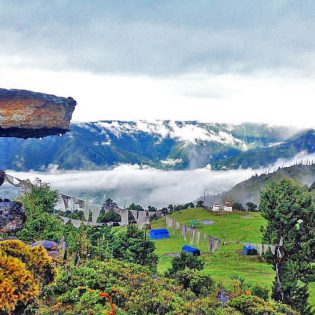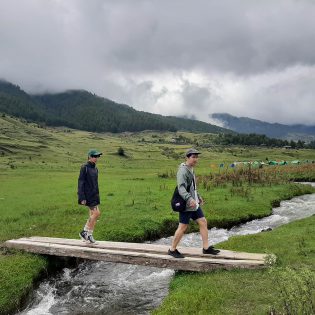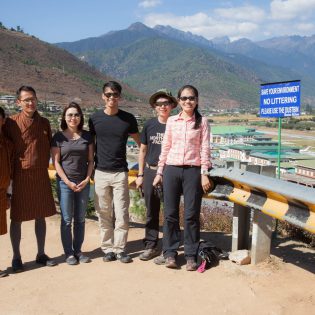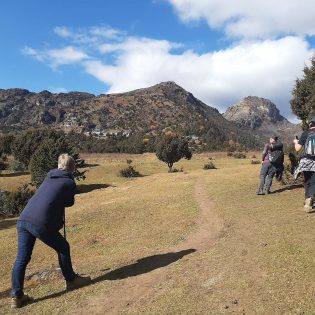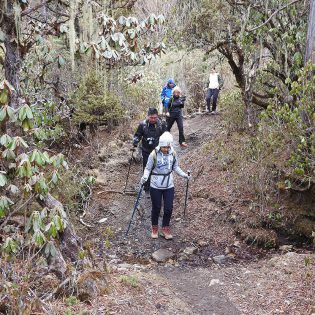Dagala Trek 13 Days Tour
This six day trek takes you into an area adorned with a multitude of pristine, crystal clear lakes. As you walk amidst the shimmering lakes you’ll be treated to stunning views of the entire Himalayan mountain range and some of the world’s highest peaks including Mt. Everest, Jomolhari, Masang Gang, Jichu Drake, Gangche Ta and many more.
During the trek an entire day will be dedicated to visiting some of the more picturesque lakes and resting. The trail also takes you through several Bhutanese villages so you can get a good idea of traditional Bhutanese village life as you make your way back from the lakes.
While this is a somewhat strenuous trek, it is well worth the effort because of the tranquility and beauty of natural landscape that you will enjoy during the journey.
The best time to embark on this trek is between April-June or September –October.
Day 01: Arrive Paro Via Flight
The flight into Paro is a befitting introduction to the spectacular beauty of our country. In clear weather, magnificent views of the world’s highest peaks, give way to the lush green Paro valley as you land. On arrival at Paro airport, you will be received by our representative from Bhutan Travel Adventures, and will escort you to the hotel.
In the afternoon visit is Ta Dzong, an ancient watchtower, which now houses the National Museum. Below the museum is the Paro Rimpung Dzong, the centre of civil and religious authority in this valley. A short walk takes you to the base of the dzong and across a traditional cantilevered, covered bridge.
A short distance further is one of the innumerable archery grounds. (Archery is the national sport of Bhutan). If you are lucky, you may catch a match in action. In the evening start sorting and packing your trekking equipment for the trek you will start tomorrow.
Day 02: Paro Tiger’s Nest (Taktshang) Hike
Right after the breakfast drive towards the road point to Taktshang. Taktshang Monastery, the most famous of Bhutan’s monasteries is perched on the side of a cliff 900m above the Paro valley floor. Taktshang means “Tiger’s Nest,” so named because Guru Rimpoche reportedly flew to the site of the monastery on the back of a flying tiger in the late centuries of the first millennium.
The monastery is perched on a cliff nearly 800 meters above the Paro valley floor. This day hike is not only historically and culturally interesting, but also incredibly scenic! It takes about 1 ½ hours to reach the cafeteria, which gives a breathtaking view of the Tiger’s Nest.
If you still feel like hiking then you can take another hour to reach the temple. Then return back to the cafeteria for your lunch and then walk down hill after your lunch.
Drive back to the hotel.
Day 03: Paro – Genekha – Gur (Trek Starts)
- Distance 7Km, Time 5 hours, Ascent 550m, Descent 60m, Camp Elev 3290 m.
From Thimphu you will drive for 45km to the starting point of the trek. Today’s trail is all through terraced fields and conifers vegetation.
The trek starts from beautiful Genekha village (2800m) with a short descent down to the river. From here – after crossing the river- you start climbing till
you reach a huge rock platform at 3350m from where you have a picturesque view of the valley below. After another 2 hours you reach Gur amid yak pastures at 3290m.
Day 04: Gur – Labatama
- Distance 12Km, Time 6 hours, Ascent 1220m, Descent 110m, Camp Elev 4100m.
While trekking across the ridges, one enjoys beauty of the rugged mountains vegetation. The path winds through flowers and wild asparagus (in spring).
The meadows are refreshing and inspiring.The first pass symbolize by a huge cairn gives a spectacular view of Kanchenjunga (Sikkim) and more or less all the Bhutanese Himalayan peaks. Once descended into the Lamatama valley you ascend gradually through the valley passing some yak herder huts till you reach Utsho Lake where
golden trouts are in abundance. The campsite is right next to the lake at 4100.
Day 05: Halt At Labatama
Today you will have a day excursion to Sertsho and Jagetsho lakes. Hike up hill to Sertsho Lake is easy and interesting after wards walk over a small ridge and then down to Jagetsho Lake. Or you can also attempt to climb the Aum Jomo, a 5000m peak if there is no snow on the Jumo Mountain.
From the summit you can have spectacular views around the Dagala range during the clear weather. Return to the camp by dusk and prepare for the next day.
Day 06: Labatama – Pankha
- Distance 8Km, Time 5-6 hours Ascent 269m, Descent 520m, Camp Elev 400m.
The trail along the western side of the Dalatsho up to a saddle at 4520m from where you can have majestic view of Himalayan peaks during descent. This point is around 4460m. The mountain peaks include Everest (Nepal), Kanchenjunga (Sikkim), Jumolhari, Jitchu Drake, Tshering Gang,
Khangbum, Masa Gang , Tshenda Gang and Gangche Ta. If you want even better view, you can climb a peak close to the saddle with an altitude of 4720m.
From the saddle the path descends, passing some yak herder huts to Docha Chu. You follow the river for a while, but stay higher up on the slop to reach Pankha with some ups and down on the way. Camp at Pankha at 4000m.
Optional Note: If you are trekking in spring time, the Pankha camp will not have drinking water.So you can hike about another 1 ½ hours further from Pankha for your tonight’s camp. And this can also make your last day easier and bit shorter too.
Day 07: Pankha – Chamgang – Thimphu (Trek Ends)
- Distance 14Km, Time 8 hours, Ascent 180m, Descent 1630m.
You will start early today. This day entails the crossing of several passes, each one more impressive than the other. Search for different varieties of Blue Poppy (June-July) and mountain birds. After crossing the last small ridge, you will gradually decent toward the main Junction pass, which
crisscrosses each other for the trail towards Chamgang, Talekha, Ganekha and Gaselo. So just make a very short descent on your right, and then take left horizontally for few minutes towards Chamgang trail with about three to four small ridges to go up and down before you begin a steep downhill hike until you reach a Chamgang village. You will finally arrive at the motor able road where transport will be awaiting to transfer you to Thimphu.

Day 08: Thimphu – Punakha
- Distance: 86.4 km; approx. driving time: 2 hrs 32 minutes
Drive to Punakha via amazing Dochula Pass (3100 meters). If the weather is clear, you could have a superb view of the Bhutan’s Himalayas from the pass. Upon arrival in Punakha, check in at the hotel first. Have lunch in Punakha town and visit:
- Punakha Dzong built in 1637 by Shabdrung Ngawang Namgyal
- Devine Madman’s temple (also called as fertility temple)

Day 09: Punakha – Phobjikha
- Distance: 78 km; approximate driving time: 3 – 4 hrs
- Altitude: 3000 m above the sea level
After breakfast, we will drive to beautiful Phobjikha Valley and after arrival check into the hotel and we will do short hike. Then visit the black crane information center which is ituated on the edge of the forest and wetland along the main road of Phobjikha valley, the black-necked crane information Centre has an observation room equipped with high power telescope and spotting scopes for catching the best view of the cranes. The centre also offers display information that outline the natural and cultural history of the area.
Overnight at hotel in Phobjikha

Day 10: Phobjikha – Thimphu
- Distance: 135 km; approximate driving time: 5 – 6 hrs
After breakfast, visit Gangatey Goenpa then start our journey to Thimphu from Phobjikha. On the way you can stop for the photo shooting and enjoying the scenic landscape and the nature. If time permits then visit Wangdue town and drive to Punakha to take lunch. After reaching
Thimphu, check into the hotel and take rest for a while and stroll through town.
Day 11: Thimphu Sightseeing
Sightseeing in Thimphu includes:
- Buddha Point (Kuenselphodrang)
- National Memorial ChortenTakin Preserve (Takin zoo)
- Changangkha Lhakhang
- Tashi Chodzong
In the evening you can stroll through the town and if you want to do shopping then your tour guide will help you.

Day 12: Thimphu Sightseeing
Today also we will do the following sightseeing:
- Changzamtog weaving center.
- Zorig Chusum (thirteen traditional visual arts and crafts that Bhutanese have practiced for generations)
- Desho (Bhutanese local made paper) factory
- If you are lucky and it coincides with the weekends then visit the centenary farmer’s
- vegetable market which will be available during the weekends.
- If time permits then visit Dechenphodrang temple and nunnery.
Day 13: Departure
In the morning our guide and driver will drop you to the airport and bid you good bye for your flight departure to onwards destination.
End of Tour
we hope to provide the ultimate best value for all our guests. We choose some of the finest hotels, offer free upgrades to make our visitors feel the most welcomed and well-taken care of while traveling in Bhutan. We take pride in providing first class accommodations for our travelers.
A wide variety of accommodations are available ranging from luxurious 5-star hotels to cozy little hotels, homestays in traditional Bhutanese homes to camping under the stars. Visitors can be assured of comfort, ambiance and hospitality.
The types of accommodations can be divided into:
- Government Categorized 3 Star Hotels and Resorts
- Luxurious 4 Star Hotels & 5 Star International Hotel Chains
- Village Homestay
- Camping
- Government Categorized 3 Star Hotels & Resorts
Hotels in Bhutan are rated according to a National 5 Star rating System. All Tour Operators are required to provide their guests with Government Categorized Hotels and Resorts, a minimum of 3 Star accommodations so you can be assured of your comfort. Most hotels provide their guests with Basic Necessities, Room Service, Free Wi-fi, Television and some of them also have Fitness Centers and Spas
Luxurious 4 Star Hotels & 5 Star International Hotel Chains
The luxury packages are based on 4 star luxury hotels and 5 star International Hotels Chain (Aman Kora, COMO Uma, Zhiwaling, Le Meridien and Taj Tashi) with extra charges in addition to the Mandatory Daily Tariff of USD $250/person/night.
Village Homestay
Visitors also have the option of spending a night in a traditional Bhutanese Farm House with a Bhutanese family. Agriculture is still one of the major sources of livelihood among the Bhutanese people and a farm-stay will give you an excellent glimpse into the day-to-day life of a typical Bhutanese family. You’ll be able to observe age old Bhutanese farming traditions as the family goes about its daily tasks. You’ll enjoy delicious home-cooked meals and the unparalleled hospitality of a Bhutanese host.
Camping
There’s nothing like camping in some of the most breath taking landscapes of Bhutan. Visitors embarking on long treks will be provided with tents and whatever other camping equipment is deemed necessary. Regardless of where you stay, visitors can be assured of their comfort and traditional Bhutanese hospitality.
What is included in this tour?
- Wedding ceremony in Bhutanese style
- Tours specified in the itinerary
- Accommodation in 4 star hotel/ Complimentary Deluxe rooms.
- Meals (Breakfast; lunch; dinner, mineral water) as per your choice
- Transportation within Bhutan (Toyota Hiace Bus/High roof)
- Services of experienced and licensed culture tour guide
- Museum fees and other special entry fees
- US $ 10 per pax for Tourism Development Fund
- Visa fee of US$ 40 per person
- Tax and government royalty
Whats not included in this tour.
- Air fare
- Travel and health Insurance( All medical facilities in Bhutan is free )
- Laundry, telephone, mobile, fax and Internet bills (Hotels in Bhutan provide free wifi facilities)
- Tips for guide and driver
- Alcohol, beverages in resorts.
- Shopping and Entertainment
How can we confirm our Bhutan Visa and tour?
Your Bhutan Visa and Bhutan tour will be 100% confirmed once the company receives your full payment. You will receive you Bhutan Visa and confirmed tickets 24-48 hours after you transfer us the full tour payment.
When is the best time to travel to Bhutan?
You can visit western Bhutan (Thimphu, Paro, Punakha and Wangduephodrang) anytime of the year. Avoid central and eastern Bhutan during the monsoon months of July and August when the weather is sometimes a little wet for sightseeing.
Do we need travel insurance?
All visitors in Bhutan are advised to get their insurance coverage from their own country.
Is tipping a standard practice?
Yes, tipping is a standard practice in Bhutan and it is part of a Bhutanese culture. All your service staff such as guide, driver, hotels staff will expect tips from you at the end of the service.
